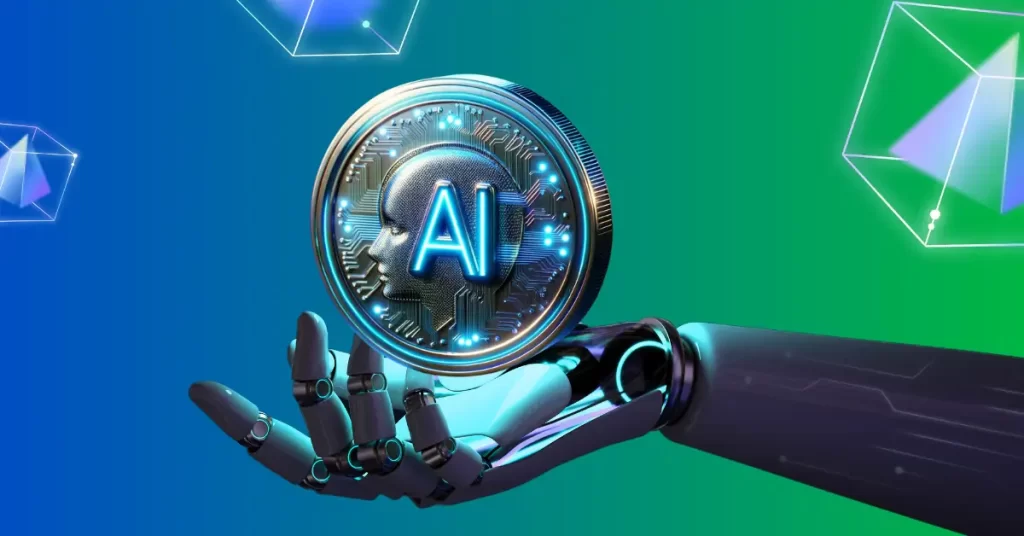The New Trends in Artificial Intelligence and Robotics

The post The New Trends in Artificial Intelligence and Robotics appeared first on Coinpedia Fintech News
Artificial intelligence and robotics have seen massive advancements in recent years, leading to new trends shaping these technologies’ future. From healthcare to automation, some of the most noteworthy trends in artificial intelligence and robotics include machine learning, autonomous robots, and personalized healthcare software.
What is Artificial Intelligence
Artificial intelligence (AI) refers to the simulation of human intelligence processes by machines, particularly computer systems. AI enables machines to perform tasks that typically require human intelligence, such as learning, reasoning, problem-solving, perception, language understanding, and decision-making.
AI systems are designed to analyze and interpret data, recognize patterns, adapt to new circumstances, and make decisions based on the information available to them. These systems can be trained using algorithms and large datasets to perform specific tasks accurately and efficiently.
There are two main types of AI: Narrow AI (also known as Weak AI) and General AI (also known as Strong AI). Narrow AI is designed to perform a narrow task, such as speech recognition or recommendation systems. At the same time, General AI aims to replicate the cognitive abilities of humans and perform any intellectual task that a human can do.
AI technologies encompass various subfields, including machine learning, deep learning, natural language processing, computer vision, robotics, and expert systems. These technologies are applied in numerous industries, including healthcare, finance, manufacturing, transportation, and entertainment, to automate processes, enhance decision-making, improve efficiency, and drive innovation. Many of these companies are investable. You can learn what is CFD trading and how the activities of AI giants like Microsoft and Amazon.
Artificial intelligence has the potential to revolutionize the way we live and work by enabling machines to mimic human cognitive functions and perform complex tasks at a level of sophistication that was previously unimaginable. As AI advances, its impact on society, ethics, and the economy will become increasingly significant, shaping the future of technology and transforming various aspects of our daily lives.
Machine Learning
Machine learning, a subset of artificial intelligence, involves algorithms that enable machines to learn and improve their performance without explicit programming. On the other hand, deep learning is a more advanced form of machine learning that uses neural networks to process large amounts of data. These technologies have revolutionized industries such as finance, healthcare, and transportation by enabling machines to make informed decisions based on patterns and trends in data.
Federated learning is a decentralized machine learning approach in which the model is trained across multiple devices or servers while localizing data. This technique maintains data privacy while benefiting from the devices’ collective knowledge.
Explainable AI focuses on making machine learning models more transparent and understandable. By explaining the decisions made by AI systems, users can better trust the results and understand their reasoning.
AutoML refers to the automation of the machine learning process, from data preprocessing and feature engineering to model selection and hyperparameter tuning. This trend aims to make machine learning more accessible to individuals with limited expertise in the field.
Reinforcement learning is a type of machine learning where agents learn by interacting with an environment and receiving feedback as rewards. This approach is instrumental in scenarios requiring decision-making and sequential actions, such as game-playing, robotics, and autonomous systems.
Transfer learning takes the information a machine has learned from one issue and applies that knowledge to improve performance on another issue. By transferring the knowledge gained from training data in one domain to another, models can quickly adapt to new datasets and tasks with limited labelled data.
Edge computing involves processing data closer to the source on smartphones, sensors, and IoT devices. By conducting machine learning tasks on the edge, latency is reduced, and privacy and security concerns are addressed.
These trends in machine learning reflect the ongoing advancements and innovations in the field, enabling more sophisticated and practical applications across various industries. As machine learning continues to evolve, researchers, developers, and practitioners must stay informed about emerging trends and technologies to leverage the full potential of this transformative discipline.
Autonomous robots
Autonomous robots are robots that can perform tasks without human intervention. These robots are equipped with sensors, cameras, and other technology to navigate and interact with their environment. Autonomous robots are used in various industries, including manufacturing, agriculture, and transportation, to streamline processes and increase efficiency.
The field of autonomous robots is witnessing many new trends shaping the development and deployment of robots with increasing levels of autonomy and intelligence.
One emerging trend in autonomous robots is using multi-robot systems, where multiple robots collaborate and communicate to perform tasks more efficiently and effectively. These systems can divide tasks among robots, share information, and coordinate actions to achieve common goals.
Swarm robotics involves coordinating large numbers of simple robots to work together in a coordinated manner, mimicking the behaviour of natural swarms of animals. This approach enables the robots to exhibit collective behaviours such as self-organization, robustness, and scalability, making them suitable for search and rescue missions, environmental monitoring, and industrial automation applications.
Another trend in autonomous robots is the integration of robots into human environments, where they can work alongside humans to enhance productivity and safety. Collaborative robots, or cobots, are designed to assist humans in various tasks, such as manufacturing, healthcare, and logistics, by sharing physical space and performing complementary actions.
As autonomous robots become more complex and capable, there is a growing need for transparency and explainability in their decision-making processes. Explainable autonomy ensures that robots can explain their actions, enabling users to understand the reasons behind their decisions and build trust in their capabilities.
Autonomous robots that can adapt to changing environments and learn from experience are gaining popularity in research and industry. These robots use machine learning algorithms to improve their performance over time, adjust to new tasks, and handle unforeseen challenges without human intervention.
With the increasing deployment of autonomous robots in various domains, there is a growing emphasis on addressing ethical and social implications. Issues such as safety, privacy, accountability, and the impact of automation on jobs and society are crucial considerations in developing and deploying autonomous robots.
These trends in autonomous robots illustrate the ongoing advancements in robotics technology, enabling robots to operate with increasing autonomy, intelligence, and adaptability. As the field continues to evolve, there is a need for interdisciplinary collaboration and ethical reflection to ensure that autonomous robots are developed and deployed responsibly and ethically.
Personalized healthcare
Artificial intelligence is transforming the healthcare industry by enabling personalized treatment plans based on individual patient data. AI-powered algorithms can analyze medical records, genetics, and other factors to predict disease risk, recommend treatment options, and even assist in surgery. Robotics are also being used in healthcare to assist in surgeries, rehabilitation, and patient care.
AI algorithms can analyze large volumes of health data, including electronic health records, imaging scans, and genetic information, to predict disease risk, identify early warning signs, and forecast treatment outcomes. Predictive analytics enable healthcare providers to deliver personalized interventions and preventive measures based on individual patient data.
Precision medicine involves tailoring medical treatments and interventions to individual characteristics, such as genetics, lifestyle, and environment. AI-powered tools can analyze patient data to identify optimal treatment options, predict medication responses, and guide personalized treatment plans for conditions ranging from cancer to chronic diseases.
AI technologies enable remote real-time patient health data monitoring, allowing healthcare providers to track vital signs, symptoms, and disease progression outside of traditional clinical settings. Remote monitoring systems powered by AI can detect potential health issues early, enable timely interventions, and improve patient outcomes in personalized healthcare.
AI-powered chatbots and virtual assistants are being used to enhance patient engagement, provide personalized health information, and offer support for managing chronic conditions. These tools can answer patient queries, schedule appointments, deliver medication reminders, and offer mental health support, contributing to improved patient outcomes and streamlined care delivery.
AI algorithms can analyze patient data, clinical guidelines, and scientific literature to generate personalized treatment recommendations for healthcare providers. These AI-powered systems help clinicians make informed decisions about treatment strategies, drug selection, dosage adjustments, and care plans tailored to individual patient needs and preferences.
AI algorithms integrated into wearable devices and sensor technologies can continuously monitor patients’ health metrics, such as heart rate, blood pressure, and activity levels. AI-powered wearables enable personalized health tracking, early detection of health issues, and real-time feedback on lifestyle habits to support preventive care and disease management strategies.
These trends in AI for personalized healthcare highlight the transformative impact of artificial intelligence on improving patient outcomes, enhancing care quality, and optimizing treatment approaches tailored to individual needs. As AI advances in healthcare, personalized medicine is gaining momentum as a critical priority for delivering patient-centric, precision care in a rapidly evolving healthcare landscape.
Chatbots and virtual assistants
Chatbots and virtual assistants are AI-powered software programs that interact with users via text or speech. These tools are becoming increasingly popular in customer service, marketing, and other industries, as they can provide quick, personalized responses to customer queries and streamline communication processes.
The Bottom Line
In conclusion, new artificial intelligence and robotics trends are revolutionizing industries and driving innovation in various fields. From machine learning to autonomous robots, these technologies are reshaping how we live, work, and interact with the world around us. As these trends continue to evolve, companies, researchers, and policymakers need to consider the ethical implications and ensure that AI and robotics are used to benefit society.



